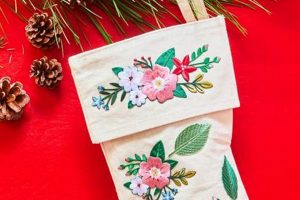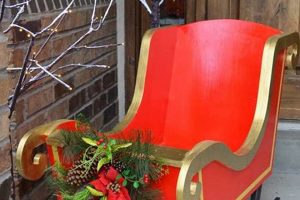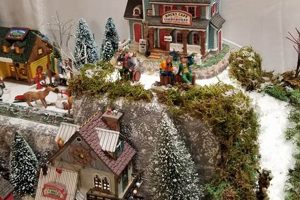Handcrafted ornamental spheres, constructed from paper and intended for seasonal holiday decoration, represent an accessible avenue for festive personalization. These decorations offer an alternative to commercially manufactured ornaments and provide an opportunity for creative expression using readily available materials. Examples include origami-inspired designs, layered paper constructions, and intricately cut paper spheres.
The practice of creating these handmade decorations fosters resourcefulness and offers a cost-effective approach to holiday decorating. The act of crafting such items can also cultivate a sense of accomplishment and provide an engaging activity for individuals or groups. Historically, handmade ornaments reflect cultural traditions and represent a tangible connection to past celebrations.
The following sections detail various techniques for constructing these paper ornaments, including material selection, step-by-step instructions for popular designs, and tips for embellishment and display. Considerations for paper weight, cutting tools, and adhesive types will also be addressed to ensure successful project completion.
Crafting Durable Paper Christmas Spheres
Achieving visually appealing and structurally sound paper Christmas spheres requires attention to detail throughout the construction process. The following tips provide guidance for optimal results, focusing on longevity and aesthetic quality.
Tip 1: Paper Selection: Opt for cardstock or heavier-weight paper. Thinner paper is prone to tearing and may not hold its shape effectively. Cardstock provides greater rigidity and durability for ornaments intended for repeated use.
Tip 2: Precise Cutting: Employ sharp cutting tools such as craft knives or precision scissors. Clean, accurate cuts are essential for intricate designs and contribute to a polished final product. Dull blades can lead to frayed edges and inaccurate shapes.
Tip 3: Adhesive Application: Utilize a high-quality adhesive formulated for paper crafts. Acid-free glue sticks or liquid adhesives with controlled application nozzles minimize wrinkling and warping. Ensure even distribution of adhesive for secure bonding.
Tip 4: Structural Reinforcement: For larger or more complex designs, consider incorporating internal reinforcement. Lightweight cardboard or wire frameworks can provide added stability and prevent deformation over time.
Tip 5: Seam Concealment: When joining paper segments, employ techniques to conceal seams effectively. Overlapping edges or strategically placed embellishments can create a seamless appearance and enhance the overall aesthetic appeal.
Tip 6: Protective Coating: Apply a sealant or clear coat to the finished ornament to protect it from moisture and dust. This measure enhances the ornament’s durability and preserves its appearance over subsequent holiday seasons.
These tips provide a foundation for creating high-quality paper ornaments. Implementing these techniques will result in more robust and visually appealing decorations.
The final section will explore various design ideas and embellishment techniques, further expanding the possibilities for creating unique and personalized holiday decorations.
1. Paper Weight
Paper weight constitutes a critical factor in the successful creation and longevity of handcrafted paper Christmas ornaments. Selection of an appropriate paper weight directly impacts the ornament’s structural integrity, visual appeal, and overall durability. Suboptimal paper weight can lead to compromised designs and reduced lifespan of the finished product.
- Structural Stability
Heavier paper weights, such as cardstock (typically 65lb or higher), provide increased rigidity and resistance to bending or tearing. This characteristic is essential for maintaining the intended shape and preventing deformation over time, especially in complex or multi-layered ornament designs. Conversely, lighter-weight papers (e.g., standard printer paper) lack the necessary structural support, resulting in fragile ornaments prone to damage.
- Crease Definition and Folding
The weight of the paper significantly affects the crispness and precision of folds. Heavier papers generally hold creases more effectively, which is crucial for origami-inspired designs or ornaments requiring sharp, defined edges. Lighter-weight papers may produce soft or rounded folds, compromising the intended aesthetic and potentially weakening the overall structure.
- Adhesive Compatibility
Different paper weights necessitate varying adhesive approaches. Lighter papers may require less aggressive adhesives to prevent warping or bleed-through, while heavier papers benefit from stronger adhesives to ensure secure bonding of seams and layers. Selecting an adhesive appropriate for the paper weight is vital for a clean and durable finish.
- Embellishment Suitability
The paper’s weight influences its ability to support embellishments such as glitter, beads, or paint. Heavier papers can withstand the added weight and moisture of these decorative elements without buckling or tearing. Lighter papers may require careful application of embellishments to avoid damage and maintain the ornament’s structural integrity.
The selection of an appropriate paper weight is thus paramount for achieving durable, aesthetically pleasing, and structurally sound handcrafted holiday ornaments. Consideration of structural demands, desired aesthetic features, and the compatibility of chosen embellishments should inform the selection process to ensure a successful outcome.
2. Folding Technique
The chosen folding technique directly determines the final form and structural integrity of paper Christmas ornaments. Precise and consistent folding methods are not merely aesthetic choices but fundamental engineering principles applied at a miniature scale. Improper folding leads to weakened structures, asymmetry, and a diminished visual appeal. For example, origami-based sphere designs demand exacting folds to achieve the desired geometric pattern and stability. In contrast, simpler layered designs require uniform folds for balanced distribution of stress and weight.
Variations in folding techniques significantly impact the ornament’s design possibilities. Modular origami allows for the creation of complex, interlocking spheres with inherent strength, while simpler folding methods are better suited for ornaments relying on adhesive for structural support. The specific technique also dictates material requirements, as certain methods demand thinner, more pliable papers to facilitate intricate folds. The application of scoring tools to create precise creases is another important aspect, particularly when using heavier cardstock. Furthermore, understanding the mathematical principles underpinning origami or geometric folding enables the creation of unique and sophisticated designs beyond simple, repetitive folds.
In summary, folding technique is inextricably linked to the successful creation of durable and aesthetically pleasing paper Christmas ornaments. Precise execution, informed by a knowledge of geometric principles and material properties, is paramount. Challenges inherent in complex folding can be mitigated through practice and the use of appropriate tools, ultimately leading to the creation of visually stunning and structurally sound decorations. The mastery of folding techniques expands the realm of possibilities for handcrafted holiday ornamentation.
3. Adhesive Strength
Adhesive strength is a critical determinant of the structural integrity and longevity of “diy paper christmas balls”. Inadequate adhesive strength results in delamination, structural collapse, and a shortened lifespan for these handcrafted decorations. The connection is a direct cause-and-effect relationship: stronger adhesives yield more durable ornaments, while weaker adhesives compromise their stability. The choice of adhesive directly impacts the ornament’s ability to withstand handling, environmental factors (humidity, temperature fluctuations), and the stresses imposed by its own weight, particularly in complex designs.
For instance, a complex origami-inspired paper sphere constructed with a low-tack glue stick will likely disintegrate over time, as the individual paper components gradually separate. Conversely, the same design, meticulously assembled using a high-quality pH-neutral adhesive specifically formulated for paper crafts, will exhibit significantly greater resilience and maintain its form for extended periods. Practical application involves careful consideration of the paper type, ornament size and complexity, and the intended environment. Ornamentation involving the addition of glitter or heavier embellishments exacerbates the demands on adhesive strength, requiring more robust bonding agents. Selection criteria should include bond strength, drying time, transparency, and acid-free formulation to prevent discoloration or degradation of the paper over time. Failure to adequately consider these parameters constitutes a significant risk to the ornament’s structural integrity and visual appeal.
In conclusion, the adhesive’s properties are not merely a minor detail, but a foundational element in the success of “diy paper christmas balls”. Selecting the correct adhesive and applying it meticulously contributes directly to the ornament’s longevity, structural stability, and overall aesthetic quality. Recognizing the interplay between adhesive strength and these factors mitigates the risk of premature failure and allows for the creation of cherished decorations designed to last for years.
4. Structural Integrity
Structural integrity, in the context of “diy paper christmas balls,” refers to the ornament’s ability to maintain its intended shape and resist deformation or collapse under its own weight or external forces. This property is not merely an aesthetic consideration; it is a fundamental requirement for a durable and long-lasting decoration. A paper ornament lacking sufficient structural integrity will sag, tear, or ultimately fall apart, negating the time and effort invested in its creation. For example, a complex origami sphere constructed from thin paper and lacking internal support will inevitably lose its shape, particularly in environments with high humidity. The selection of appropriate materials, the precision of construction techniques, and the incorporation of reinforcing elements are all critical factors in achieving adequate structural integrity. The absence of any one of these factors can compromise the entire ornament.
The practical significance of understanding and implementing structural integrity principles is evident in the longevity of handcrafted ornaments. A well-constructed paper sphere, designed with a focus on structural stability, can withstand years of handling and storage, becoming a cherished part of holiday traditions. Techniques such as using heavier weight paper, employing interlocking folding patterns, and incorporating internal supports (e.g., wire frameworks or cardboard cores) contribute directly to enhanced structural stability. Furthermore, the choice of adhesive and its application method play a crucial role in maintaining the bond between individual paper components, preventing delamination and preserving the ornament’s form. Without a sound understanding of these principles, the resulting ornaments are likely to be fragile and short-lived, failing to meet the expectations of a lasting holiday decoration.
In summary, structural integrity constitutes a vital, non-negotiable element in the creation of successful “diy paper christmas balls.” Its attainment requires careful consideration of material selection, construction techniques, and environmental factors. The challenges inherent in achieving robust structural stability can be overcome through informed design choices and meticulous execution. A focus on structural integrity transforms what could be a fleeting craft project into a lasting and cherished holiday heirloom, highlighting the importance of this principle in the broader context of handcrafted decorations.
5. Embellishment Style
Embellishment style, in the context of “diy paper christmas balls,” represents the application of decorative elements and techniques to enhance their visual appeal and personalize their aesthetic expression. The choice of embellishment directly impacts the ornament’s final appearance, reflecting individual creativity and aligning with specific holiday themes or personal preferences.
- Material Selection
The selection of embellishment materials is a fundamental aspect of defining the overall style. Options range from glitter and sequins for a sparkling, festive look to paint and metallic markers for intricate designs. Natural elements such as dried flowers or miniature pinecones can evoke a rustic, organic aesthetic. The chosen materials must be compatible with the paper substrate to prevent damage or distortion. For example, heavy beads may require reinforcing the paper structure to prevent tearing.
- Technique Application
Various techniques can be employed to apply embellishments, each contributing to a distinct style. Painting, both freehand and stencil-based, allows for detailed imagery and color customization. Decoupage, involving the application of paper cutouts, creates layered effects. Glittering, while simple, requires careful execution to avoid excessive shedding. The chosen technique should complement the ornament’s design and the desired level of detail. Intricate painting techniques may be better suited for larger ornaments with smoother surfaces.
- Color Palette
The color palette employed in embellishment significantly influences the overall aesthetic. Traditional Christmas colors (red, green, gold) evoke a classic festive feel. Modern palettes might incorporate cool tones (silver, blue, white) for a contemporary look. Monochrome schemes create a sophisticated, minimalist effect. The color choices should harmonize with the existing holiday decor and reflect the intended mood. A muted color palette may be preferred for a vintage or rustic style.
- Thematic Consistency
Maintaining thematic consistency between the ornament’s design and its embellishments is crucial for a cohesive visual presentation. Ornaments based on winter landscapes benefit from embellishments such as artificial snow or miniature figurines. Geometric designs can be enhanced with metallic accents or precisely placed sequins. The chosen theme should guide the selection of embellishment materials and techniques to ensure a unified and aesthetically pleasing result. A whimsical theme might incorporate playful elements such as googly eyes or miniature pom-poms.
These facets highlight the interconnectedness of embellishment style with “diy paper christmas balls.” The deliberate selection and application of decorative elements transform simple paper creations into personalized expressions of holiday spirit. Careful consideration of material compatibility, technique proficiency, and thematic consistency ensures a visually compelling and aesthetically harmonious outcome, elevating the craft project to a meaningful and cherished holiday decoration.
Frequently Asked Questions Regarding Paper Christmas Ornaments
This section addresses common inquiries and concerns pertaining to the creation and maintenance of handcrafted paper Christmas ornaments. The information provided aims to offer clarity and guidance for individuals engaging in this craft.
Question 1: What types of paper are most suitable for crafting durable Christmas ornaments?
Answer: Cardstock or heavier-weight papers are generally recommended for their structural rigidity and resistance to tearing. These materials provide a more robust base for intricate designs and embellishments compared to standard printer paper.
Question 2: How can the longevity of paper Christmas ornaments be extended?
Answer: Several factors contribute to ornament longevity, including the use of acid-free adhesives, protective coatings (e.g., sealant sprays), and careful storage practices. Avoiding exposure to moisture and direct sunlight is also crucial.
Question 3: What adhesives are recommended for paper ornament construction?
Answer: pH-neutral adhesives formulated specifically for paper crafts are preferred. Glue sticks, liquid adhesives with controlled applicators, and double-sided tapes offer varying levels of bond strength and precision. Always test the adhesive on a scrap piece of paper before applying it to the ornament.
Question 4: How can intricate paper ornament designs be effectively cut?
Answer: Sharp cutting tools, such as craft knives or precision scissors, are essential. Using a self-healing cutting mat and employing templates or stencils can improve accuracy and consistency. Patience and a steady hand are also necessary for complex designs.
Question 5: What methods can be used to prevent paper from warping or wrinkling during the ornament construction process?
Answer: Applying adhesive sparingly and evenly can minimize warping. Using a bone folder or similar tool to smooth out paper surfaces and creases can also help prevent wrinkles. Allowing sufficient drying time between steps is crucial.
Question 6: How can paper Christmas ornaments be safely stored between holiday seasons?
Answer: Storing ornaments in acid-free tissue paper within a rigid container protects them from dust, moisture, and physical damage. Avoid stacking heavy objects on top of the container. Storing ornaments in a cool, dry location is recommended.
These FAQs provide foundational information for creating and preserving paper Christmas ornaments. Adhering to these guidelines enhances the likelihood of producing durable and aesthetically pleasing decorations.
The following section will delve into advanced techniques and design considerations for crafting unique paper Christmas ornaments.
diy paper christmas balls Conclusion
This exploration has elucidated critical aspects of “diy paper christmas balls” construction, encompassing material selection, folding techniques, adhesive properties, structural integrity, and embellishment styles. Each element contributes significantly to the overall quality and longevity of these handcrafted decorations.
The successful creation of these ornaments necessitates a meticulous approach and a thorough understanding of the principles outlined herein. Diligent application of these insights will enable the production of enduring and visually appealing decorations, enhancing the festive ambiance for years to come.







